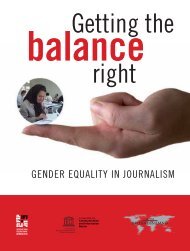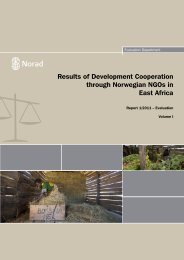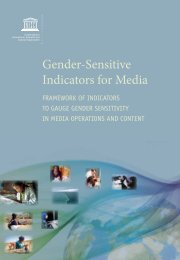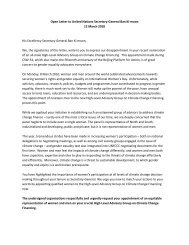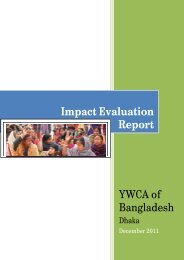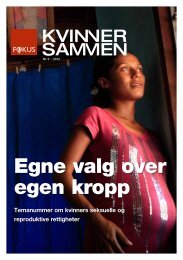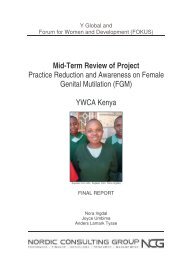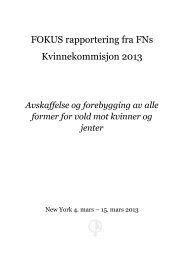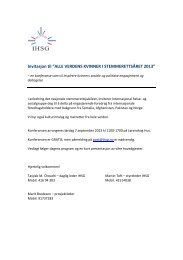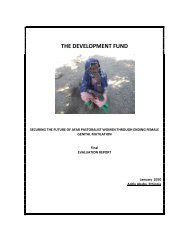TRAINING AND INFORMATION CAMPAIGN ON THE ... - Fokus
TRAINING AND INFORMATION CAMPAIGN ON THE ... - Fokus
TRAINING AND INFORMATION CAMPAIGN ON THE ... - Fokus
Create successful ePaper yourself
Turn your PDF publications into a flip-book with our unique Google optimized e-Paper software.
the Situation of Women and Children” estimates that of all women aged 15-49, 78% have undergone<br />
FGM, while 64% of mothers in the same age-group have at least one daughter who has undergone the<br />
practice (UNICEF 2009), seemingly indicating a reduction in prevalence.<br />
These numbers, however, hide the complexity of who in The Gambia is actually practicing FGM and<br />
why. Daffeh et al. caution that previous literature on FGM in The Gambia has displayed “a gap between<br />
theory and practice, with regard to ethnicity” (Daffeh 1999). Daffeh et al. go on to assert that in the Gambian<br />
case, the “ethnic classifications with regard to FGM are much more complex than was hitherto apparent”<br />
(ibid). They are referring to general statements, such as “Wollofs don’t practice female circumcision,”<br />
which various Gambians commonly repeat without qualification. When Wollof girls do undergo FGM, it<br />
has usually been explained as due entirely to pressure from individuals of other ethnic backgrounds that<br />
causes co-wives or schoolmates to “join” their peers in circumcision. It appears, however, that the rate of<br />
circumcision for girls who identify as Wolof (but could have multi-ethnic heritage) is actually quite high.<br />
The Daffeh report presents more nuanced data on ethnicity, focusing on the variation in circumcision<br />
according to ethnic sub-group and ancestral geographic origin. Thus, they argue, for certain sub-groups of<br />
Wollofs FGM is as strong a tradition as it is for Mandinkas and Serahules, among whom the practice is said<br />
to be virtually universal. A total of 96% of Jolas circumcise females, again with variation across sub-goups<br />
(ibid). The authors of the 1999 report conclude that the only ethnic groups in The Gambia that do not at<br />
all practice FGM are the Creoles, the Lebanese, and the Manjagos (ibid).<br />
Although these numbers do throw light on a previously poorly understood area, ethnic and even<br />
sub-ethnic labels are not entirely reliable as indicators of whether a girl will undergo FGM or not. It is<br />
important to note that marriage across ethnic lines is very common and relatively unproblematic in The<br />
Gambia, and that it is typical to encounter Gambians whose relatives come from two or more ethnic<br />
groups. The age at which girls are circumcised is also somewhat tied to ethnicity, although not in any<br />
simple way. Serahule communities generally practice FGM in the first week of the girl’s life, coinciding<br />
with her naming ceremony. In other ethnic communities, the age of circumcision may vary widely.<br />
When initiations take place in a communal context, a group of girls may include infants, young children,<br />
and even teenagers, depending on how long the ritual cycle is until another big celebration rolls around.<br />
In general, however, there is clearly a trend in The Gambia, as elsewhere in Africa, to “circumcise” girls<br />
at a younger and younger age.<br />
Additionally, geographic location impacts prevalence rates. Project reports from The Gambia typically<br />
refer to urban versus rural areas, but it can be a bit difficult to define the two (according to the 2009<br />
UNICEF study, 72% of urban women have undergone FGM, 83% of rural). The Gambia has no true<br />
cities – the capital of Banjul is a sleepy town of a mere 50,000 or so. Most population growth is taking<br />
place in the nearby peri-urban areas of Bakau and Serrekunda – sprawling, densely populated towns<br />
predominantly populated by rural migrants. The 1993 Gambian census bases its definition of “urban”<br />
on: commercial and institutional importance, majority of population engaged in non-agricultural work, a<br />
population of 5,000 or more, high population density, and the presence of some infrastructure. In terms<br />
of FGM, however, prevalence rates in The Gambia do not correspond to facile assumptions of rural<br />
“traditionalism” and urban “progressiveness.” As evidenced in GAMCOTRAP’s reports on its campaign<br />
activities, community abandonment of harmful traditional practices can often be found clustered in very<br />
remote rural areas otherwise considered “traditional,” while the practice remains entrenched in “urban”<br />
centers such as Bakau and Brikama. Additionally, there is – despite the very small size of the country – a<br />
great deal of regional variation in the reach of anti-FGM interventions. Despite past attempts to coordinate<br />
the efforts of various NGOs involved in anti-FGM education and activism, in reality certain regions (such<br />
as the Basse area in URR) have been targeted by sensitization efforts of several different groups, while<br />
other areas (in particular on the North Bank) remain essentially unreached.<br />
10




